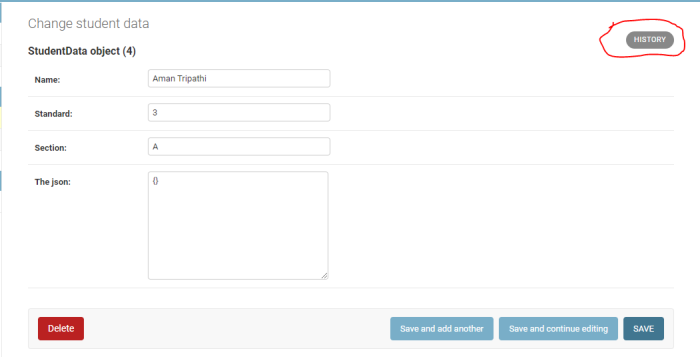Django 中模型对象的版本追踪
模型历史追踪是一个追踪模型对象变化的功能,它追踪诸如你做了什么更改以及何时删除了对象等信息。它还有助于恢复已删除的模型对象。在本文中,我们将通过一个示例来了解如何在 Django 中追踪模型对象的版本历史。
示例
首先,设置你的项目、应用、URL 和模型。
安装 **django-simple-history** 库:
pip install django-simple-history
在 **settings.py** 中:
INSTALLED_APPS+=[" simple_history"] MIDDLEWARE = [ #other middle ware 'simple_history.middleware.HistoryRequestMiddleware', ]
在这里,我们添加了 **"simple_history"** 模块作为应用和中间件。
因为我们的主要工作是 **models.py** 和 **admin.py**,所以在 **urls.py** 和 **views.py** 中我们不需要做太多事情。
在 **models.py** 中,添加以下内容:
from django.db import models from simple_history.models import HistoricalRecords # Create your models here. class StudentData(models.Model): name=models.CharField(max_length=100) standard=models.CharField(max_length=100) section=models.CharField(max_length=100) history = HistoricalRecords()
在这里,我们简单地创建了一个模型和一个 history 字段,它将保存每一次更改。
在 **admin.py** 中,添加以下几行:
from django.contrib import admin from .models import StudentData from simple_history.admin import SimpleHistoryAdmin admin.site.register(StudentData,SimpleHistoryAdmin)
在这里,我们将带有历史追踪功能的模型注册到 admin 中。
现在运行以下命令:
python manage.py makemigrations python manage.py migrate python manage.py createsuperuser
现在一切就绪了。**models.py** 中的以上代码将所有历史数据保存在一个字段中,你可以在 **views.py** 或 Django shell 中访问它。
输出




你可以在 **views.py** 或 Django shell 中查询它。

广告

 数据结构
数据结构 网络
网络 关系数据库管理系统 (RDBMS)
关系数据库管理系统 (RDBMS) 操作系统
操作系统 Java
Java iOS
iOS HTML
HTML CSS
CSS Android
Android Python
Python C 语言编程
C 语言编程 C++
C++ C#
C# MongoDB
MongoDB MySQL
MySQL Javascript
Javascript PHP
PHP